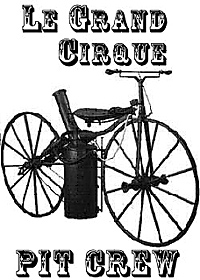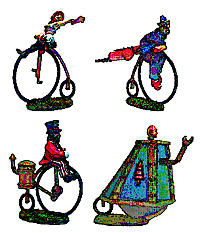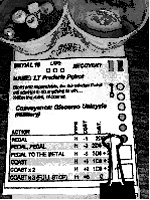 A grand adventure in the nineteenth century that never was (but might have been)
A grand adventure in the nineteenth century that never was (but might have been)
Preamble
From HISTORICAL EXCERPT, MEMOIRS OF THE STEAM AGE, Volume 3 by Winston Churchill:
In the waning half of the nineteenth century, the world suffered through a long series of increasingly profligate, devastating and senseless conflicts. The first of which, the Crimean War, lasted four long years, and resulted in little more than the obliteration of the Russian Black Sea fleet and devastation of most of the Balkans. The bloody successor in the New World, the American Civil War, lasted seven years—a period of unparalleled technological progress in the arts and machineries of war, and the resulting devastation of the land once known as “The American South” set a new low in the annals of conduct of war in the so-called enlightened nations. The European liaison officers sent to observe the endless struggle sent back reports to Europe of battlefields undreamt of in the recent Crimean conflict—of steam leviathans belching fire, and electric rays from galvanic generators, and black smoke that seared the lungs of troops on the battlefield. The reports, vividly described in European newspapers, both filled the readers with dread and thrilled the imaginations of the military mind. Ah, such possibilities! Such undreamt of carnage!
As the armories of Europe lit their forge fires, the blossoming antiwar movements reacted with alacrity. Spearheaded by the suffragette/humanitarian movement in the United States, such stalwart females as Elizabeth Cady Stanton, Hannah Longshore Myers, and Lucretia Mott joined forces with prominent former abolitionists such as William Lloyd Garrison to form the American Peace Movement. In Europe, the prototype of the International Red Cross, led by Florence Nightingale, became increasingly politicized as the threat of a continental Gotterdammerung loomed. A global disarmament conference was proposed by the IRC, with somewhat lukewarm results and participation.
It would take another brushfire war in the Western Hemisphere to change the course of the world leaders. This time, it was the incursion of the Juarista rebels against the rightful Emperor of Mexico, Maximillion I. The long and bloody conflict, financed in some part by Mexico’s Northern neighbor and fellow republic, the United States, achieved the goals of the Juaristas in a series of increasingly bloody actions, culminating in the Battle of Bexar (100,000 casualties).
The Juarista Cavalry’s use of surplus Steam Leviathans from the American Civil War, in conjunction with the poison gas bombardment from the French dirigible (L'Aigle), resulted in a battlefield so devastated that it is estimated that nothing will grow there for two more generations. It is then that the Great Powers, who had been so timid to act before, began to take notice. Still, it would have been for nought, had not an extraordinary confluence of circumstance transpired to bring about the Grand Circuit Race movement. A middle-aged British officer by the name of Hiram Oliphaunt was assigned to observe the Maximillion War, and was on hand at Vera Cruz when the French Foreign Legion was attempting to negotiate departing Mexico under the terms of the Peace of Soledad. As every schoolboy knows, the local commander was disinclined to show the Legionnaires the courtesy of surrender under arms.
 Figure 1: Eureka Pennyfarthing Cuirassiers
Figure 1: Eureka Pennyfarthing Cuirassiers
The Legion proved intractable, and things might have gone very ill indeed, but for Oliphaunt, from the back of the room, suggesting that perhaps they ought to resolve the dispute with a game of cricket, the winner accepting the results of the race as the dictum under which La Legion would withdraw. As a decent cricket bat was not available anywhere south of Philadelphia in the Western Hemisphere, the contestants opted for racing a set of Pennyfarthing bicycles the late emperor had had imported to play at tent-pegging with.
The historic results of that race are engraved in almost every Briton’s memory—Le Clerc by half a length over Mendoza at the very finish. The Juaristas were as good as their word, and the Foreign Legion lived to fight another day. Oliphaunt related this incident to his superiors at the Horse Guards – taking a characteristically self-aggrandizing viewpoint. The Horse Guards took notice of the concluding paragraphs, describing the race, the result, and the harmonious conclusion with some degree of interest. The report was forwarded to government, and the rest, they say, is history. Grand Circuit races-- dubbed with the unfortunate moniker “Le Grand Cirque” or “the big circus” by the French (a name that has held fast despite the efforts of Her Majesty’s government to suppress it) has become an accepted form of international deal-making.
The choice of Hiram Oliphaunt, the observing officer at Vera Cruz, to become the head of the International Grand Circuit Commission was at first hooted at in the popular press. Fate works in mysterious ways. Oliphaunt, the living embodiment of John Bull, became a thoroughly capable and dedicated racing official, and lived to preside over races in the Western Hemisphere, Latin America, and eventually, to mediate a colonial conflict on Mars in his last years.
INTRODUCTION
 Le Grand Cirque (LGC) is a silly game about people driving contraptions around a racetrack in order to keep from blowing each other up. Bob and Cleo have been after me to get this article done for about six months now, so here it is, a story of the Grand Adventure of Le Grand Cirque: how it came to be, and how you can throw a race, too. LGC was initially inspired by the wonderful figures of Mr. Nic Robson from Eureka Miniatures. Nic’s viewpoint of the world is pleasantly twisty—“whimsical” in another era—and his creations display this trait nicely.
Le Grand Cirque (LGC) is a silly game about people driving contraptions around a racetrack in order to keep from blowing each other up. Bob and Cleo have been after me to get this article done for about six months now, so here it is, a story of the Grand Adventure of Le Grand Cirque: how it came to be, and how you can throw a race, too. LGC was initially inspired by the wonderful figures of Mr. Nic Robson from Eureka Miniatures. Nic’s viewpoint of the world is pleasantly twisty—“whimsical” in another era—and his creations display this trait nicely.
Figure 2: In LGC Terms, Miss Fifi, The Crimson Mandarin, Industrialist Oliver Hazzard, and the Sinister Prussian, Colonel Klaw
Whether a group of Napoleonic style lancers on unicycles (!), or Hollywood style African Amazons, or Prussians with cannons mounted on their helmets, or a group of wildly eclectic bicycle racers, Nic has maintained a Grand Guignol level of absurdity throughout his non-historical creations. When I found the diminutive Eureka booth at HISTORICON in 1999, I immediately was so taken with Nic’s figures I bought one of each, and two of many, right on the spot. Nic’s Victorian Science Fiction (VSF) universe is called Pax Limpopo—I’ve heard him describe it to me at least twice (very late at night, in the lounge at the Lancaster Host so not much stuck, alas), and I can tell you it involves Queen Victoria marrying Shaka Zulu. That much I remember.
So here I was with a group of pleasantly sculpted bicycle and unicycle miniatures (mostly) and no idea how to incorporate them into the era I was gaming with back then, the Wild West. True, it was the Wild West with Hollywood critters running amok in it, but hardly Hyde Park nonetheless. The bicycle figures naturally suggest a race.
It’s fairly easy to imagine a bicycle race – you pedal madly until you get very tired, coast a while, then pedal madly again when you have caught your second wind. So, to make a game out of it, you come up with an initiative system, substitute dice for inches, add some sort of fatigue mechanism, and you’re home free, right? Well, it’s a good model if you are just simulating a race inside a track, I guess—but it sounds like it could be awfully dull after a while. And so it proved.
 What’s the fun in pedaling around a race course? There’s no game there. I wanted to add some generic mechanism that could handle a bicycle, or a steam engine, or a rocket on a backpack (with roller skates of course). So I went back to the drawing board. It occurred to me then that ANY race is really about energy, not about what you are driving, per se. I experienced what the Japanese call satori, or perfect harmony. It’s all about energy! I could have separate mechanisms for GETTING and SPENDING energy, but the old “dice for inches” would serve more than adequately as a movement model.
What’s the fun in pedaling around a race course? There’s no game there. I wanted to add some generic mechanism that could handle a bicycle, or a steam engine, or a rocket on a backpack (with roller skates of course). So I went back to the drawing board. It occurred to me then that ANY race is really about energy, not about what you are driving, per se. I experienced what the Japanese call satori, or perfect harmony. It’s all about energy! I could have separate mechanisms for GETTING and SPENDING energy, but the old “dice for inches” would serve more than adequately as a movement model.
My first cut on Energy Tracking as a game system was fairly neat, in my opinion. I created a bunch of mini-clipboards with small plastic cups glued to them. You started with a number of beads in the cup on the left (Potential Energy) and transferred it to the one on the right (Expended/Recovering Energy). I was pleased with the results, gamewise, but the bead in cup idea was becoming a complete chore. For one thing, the clipboards didn’t store flat, and the cups kept coming unglued. It also added tons of setup time to a game. On the plus side, you can definitely SEE where your energy is going and try to get it back. Even though the clipboard idea was a noble failure, I found the information ON the clipboards to be most valuable in creating a new design.
Back to Novag's Gamer's Closet Spring 2002 Table of Contents
Back to Novag's Gamer's Closet List of Issues
Back to MagWeb Master Magazine List
© Copyright 2002 by Novag
This article appears in MagWeb (Magazine Web) on the Internet World Wide Web. Other articles from military history and related magazines are available at http://www.magweb.com